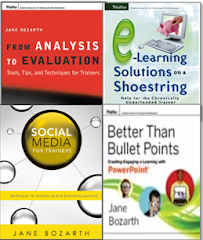Last night as we were winding down, and after a good deal of nudging from the man next to her, a woman named Vivian got up on stage. She's been playing for 2 1/2 weeks. Weeks. Before she began she said:
"I took piano lessons for a year when I was six. The night of my recital I walked out on stage in my beautiful blue satin gown my grandmother made for the occasion. We weren't allowed to have music; we were expected to play our pieces by heart. I sat down on the bench and started to play and then -- I couldn't remember what came next. I just froze. And I hung my head. And I remember now how it felt when I looked down and saw big teardrops falling down onto my beautiful new satin dress. I haven't touched an instrument since then."
She put some printed music on a stand, then played and sang a lovely rendition of Leonard Cohen's "Hallelujah".
In my work I run into a lot of "blame the learner" mentality: "They can't use the technology, and they don't want to learn, and they don't care, and no matter how many times we go over it they go back to work and do it wrong." And I recently read -- really -- "There are no learning problems in corporate settings. There are only people unwilling to learn."
I promise you no one wanted to learn more than 6 year old Vivian. But put a good performer in a bad system and the system will win every time.
Let's talk about Vivian. She was 6 years old and:
Was expected to perform.
Before she was ready.
In an unnatural setting.
In public.
With "bosses" watching.
By memory.
Without a job aid.
I suppose you get my point.
Last night Vivian was ready to try again. It wasn't quite this, but it wasn't bad at all. And it only took her 56 years.










